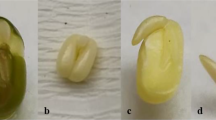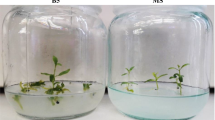Abstract
Hairy root cultures of Oldenlandia umbellata L. was established by infecting leaf explants with wild type Agrobacterium rhizogenes strain (MTCC 532). Leaf explants were co-cultured with activated bacteria in half strength Murashige and Skoog (MS) basal medium containing 500 mg l−1 ampicillin for the induction of hairy roots. To facilitate effective transfer of T-DNA of Ri plasmid, duration of co-cultivation and concentration of acetosyringone were standardized as 48 h and 200 µM, respectively. Roots were produced from the infected leaves within 14 days. Fast growing roots (2–3 cm) were excised and sub-cultured in half strength basal MS liquid medium for the development of transgenic lines. Thus ten hairy root lines were raised and superior line L3 was selected on the basis of fresh weight (1.5 g), dry weight (0.26 g) and anthraquinone (AQ) content (10.374 mg g−1 dry wt). Superior line (L3) was further cultured to test stability of AQ production and found that stable production of AQ during five consecutive sub-cultures. High performance liquid chromatographic method was adopted for quantification of purpurin from samples. Hairy roots produced 21.83 mg g−1 purpurin, while roots from wild growing plants produced 6.08 mg g−1 purpurin. Thus purpurin content in hairy roots was about 3.6 times higher than wild growing roots. Further, polymerase chain reaction based amplification using primers specific for genes rolA, rolB, and rolC confirmed the transformation.




Similar content being viewed by others
References
Aoki, S., & Syono, K. (1999). Synergistic function of rolB, rolC, ORF13 and ORF14 of TL-DNA of Agrobacterium rhizogenes in hairy root induction in Nicotiana tabacum. Plant Cell Physiology, 40, 252–256.
Bonhomme, V., Laurain-Matter, D., Lacoux, J., Fliniaux, M. A., & Jacquin-Dubreuil, A. (2000). Tropan alkaloid production by hairy roots of Atropa belladona obtained after transformation with Agrobacterium rhizogenes 15834 and Agrobacterium tumefaciens containing rol A, B, C genes only. Journal of Biotechnology, 81, 151–158.
Borroto, J., Coll, J., Rivas, M., Blanco, M., Concepcion, O., Yudelsy, A., et al. (2008). Anthraquinones from in vitro root culture of Morinda royoc L. Plant Cell Tissue Organ Culture, 94, 181–187.
Bulgakov, V. P. (2008). Functions of rol genes in plant secondary metabolism. Biotechnology Advances, 26, 318–324.
Bulgakov, V. P., Tchernoded, G. K., Mischenko, N. P., Shkryl, Y. N., Fedoreyev, S. A., & Zhuravlev, Y. N. (2004). The rolB and rolC genes activate synthesis of anthraquinones in Rubia cordifolia cells by mechanism independent of octa decanoid signaling pathway. Plant Science, 166, 1069–1075.
Frackowiak, A., Skibinski, P., Gawel, W., Zaczynska, E., Czarny, A., & Gancarz, R. (2010). Synthesis of glycoside derivatives of hydroxylanthraquinone with ability to dissolve and inhibit formation of crystals of calcium oxalate; potential compounds in kidney stone therapy. European Journal of Medicinal Chemistry, 45, 1001–1007.
Giri, A., & Narasu, L. (2000). Transgenic hairy roots: Recent trends and applications. Biotechnology Advances, 18, 1–22.
Hagendoorn, M. J. M., Van der Plas, L. H. W., & Segers, G. J. (1994). Accumulation of anthraquinones in Morinda citrifolia cell suspensions. Plant Cell Tissue Organ Culture, 38, 227–234.
Han, Y. S., Van der Heijden, R., Lefeber, A. W. M., Erkelens, C., & Verpoorte, R. (2002). Biosynthesis of anthraquinones in cell cultures of Cinchona ‘Robusta’ proceeds via the methyl erythritol 4-phosphate pathway. Phytochemistry, 59, 45–55.
Han, Y. S., Van der Heijden, R., & Verpoorte, R. (2001). Biosynthesis of anthraquinones in cell cultures of the Rubiaceae. Plant Cell, Tissue Organ Culture, 67, 201–220.
Henzi, M. X., Christey, M. C., & McNeil, D. L. (2000). Factors that influence Agrobacterium rhizogenes-mediated transformation of broccoli (Brassica oleracea L. var. italica). Plant Cell Reports, 19, 994–999.
Huang, Q., Lu, G., Shen, H., Chung, C. M., & Ong, N. M. (2007). Anti-cancer properties of anthraquinones from rhubarb. Medicinal Research Reviews, 27, 609–630.
Krishnan, S. R. S., & Siril, E. A. (2015). Enhanced in vitro shoot regeneration in Oldenlandia umbellata L. by using quercetin: A naturally occurring auxin-transport Inhibitor. In Proceedings of National Academy of Science, India, Section B biological sciences. doi:10.1007/s40011-015-0672-0.
Kumary, J. K., & Sinha, A. K. (2004). Resurgence of natural colourants: A holistic view. Natural Product Research, 18, 59–84.
Lajis, N. H., Abdullah, M. A., Ismail, N. H., Ali, A. M., Marziah, M., Ariff, A. B., et al. (2000). Anthraquinones from cell suspension culture of Morinda elliptica. Natural Product Science, 6, 40–43.
Ono, N., & Tian, L. (2011). The multiplicity of hairy root cultures: Prolific possibilities. Plant Science, 180, 439–446.
Roy, A., Lakshmi, T., & Geeta, R. V. (2012). Estimation of quercetin in Acacia catechu ethanolic bark extracts by HPLC method. International Journal of Pharm Tech Research, 4, 501–505.
Shkryl, Y. N., Veremeichik, G. N., Bulgakov, V. P., Tchernoded, G. K., Mischenko, N. P., Fedoreyen, S. A., & Zhuravlev, Y. N. (2008). Individual and combined effect of rol A, B and C genes on AQ production in Rubia cordifolia transformed calli. Biotechnology and Bioengineering, 100, 118–125.
Singh, R., & Chauhan, S. M. S. (2004). 9,10-Anthraquinones and other biologically active compounds from the genus Rubia. Chemistry & Biodiversity, 1, 1241–1264.
Siva, R. (2007). Status of natural dyes and dye yielding plants in India. Current Science, 92, 916–925.
Siva, R. (2010). Plant dyes. In B. Singh (Ed.), Industrial crop and uses (pp. 349–357). Wallingford: CAB International.
Siva, R., Mayes, S., Behera, S. K., & Rajasekaran, C. (2012). Anthraquinones dye production using root cultures of Oldenlandia umbellata L. Industrial Crops and Products, 37, 415–419.
Siva, R., Mudgal, G., Rajesh, D., Khan, F. N., Vijyakumar, V., & Rajasekaran, C. (2009). Characterization of novel pH indicator of natural dye Oldenlandia umbellata L. Natural Product Research, 23, 1210–1217.
Snedecor, G. W., & Cochran, W. G. (1962). Statistical methods (4th ed.). Iowa: The Iowa State University Press.
Sreeranjini, S., & Siril, E. A. (2013). Production of anthraquinones from adventitious root derived callus and suspension cultures of Morinda citrifolia L. in response to auxins, cytokinins and sucrose levels. Asian Journal of Plant Science and Research, 3, 131–138.
Srivastava, S., & Srivastava, A. K. (2007). Hairy root culture for mass-production of high-value secondary metabolites. Critical Reviews in Biotechnology, 27, 29–43.
Stieger, P. A., Meyer, A. D., Kathmann, P., Frundt, C., Niederhauser, I., Barone, M., & Kuhlemeier, C. (2004). The orf13 T-DNA gene of Agrobacterium rhizogenes confers meristematic competence to differentiated cells. Plant Physiology, 135, 1798–1808.
Zhou, M. L., Zhu, X. M., Shao, J. R., Tang, Y. X., & Wu, Y. M. (2011). Production and metabolic engineering of bioactive substances in plant hairy root culture. Applied Microbiology and Biotechnology, 90, 1229–1239.
Acknowledgments
The authors are thankful to Dr. P.M. Radhamany, Professor and Head, Department of Botany, University of Kerala for facilities provided. SKSR thanks University of Kerala, Thiruvananthapuram, India for granting University JRF (Ac E1B1/43700/2011 dt. 26/12/11).
Author information
Authors and Affiliations
Corresponding author
Rights and permissions
About this article
Cite this article
Saranya Krishnan, S.R., Siril, E.A. Induction of hairy roots and over production of anthraquinones in Oldenlandia umbellata L.: a dye yielding medicinal plant by using wild type Agrobacterium rhizogenes strain. Ind J Plant Physiol. 21, 271–278 (2016). https://doi.org/10.1007/s40502-016-0229-0
Received:
Accepted:
Published:
Issue Date:
DOI: https://doi.org/10.1007/s40502-016-0229-0




